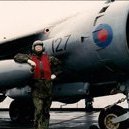Search the Community
Showing results for tags 'In Action'.
-
Northrop P-61 Black Widow Squadron Publications In Action The Northrop P-61 Black Widow, named for the American spider, was the first operational U.S. military aircraft designed specifically for night interception of opposing aircraft, and was the first aircraft specifically designed to use radar. It was an all-metal, twin-engine, twin-boom design developed during World War II. The first test flight was made on 26 May 1942, with the first production aircraft rolling off the assembly line in October 1943. The last aircraft was retired from government service in 1954. Although not produced in the large numbers of its contemporaries, the Black Widow was effectively operated as a night-fighter by United States Army Air Forces squadrons in the European Theatre, the Pacific Theatre, the China Burma India Theater and the Mediterranean Theatre during World War II. It replaced earlier British designed night-fighter aircraft that had been updated to incorporate radar when it became available. After the war, the P-61 served in the United States Air Force as a long-range, all weather, day/night interceptor for Air Defence Command until 1948, and Fifth Air Force until 1950. On the night of 14 August 1945, a P-61B of the 548th Night Fight Squadron named "Lady in the Dark" was unofficially credited with the last Allied air victory before VJ Day. The P-61 was also modified to create the F-15 Reporter photo-reconnaissance aircraft for the United States Air Force. This book is published in Squadron Publications standard landscape format this book is filled with excellent photographs and information that will invaluable to the modeller. After a short introduction explaining the development of nightfighter aircraft along with a couple of shots of the P-70 Havocs and Beaufighters used by the USAAF the book concentrates on the P-61. Starting with the development of the type in the form of the XP-61 the photo narrative takes the reader through the modifications, equipment, weaponry and crew stations in a series of really useful photographs. Each photograph is nicely annotated giving the aircraft type, number and location. Along with the superb black and white photos there are a fair few in full colour which really show well how the aircraft soon became very weathered and tired looking, there3 are several colour profiles and line drawings showing the differences between the main marks. The book then moves on to the in service photos of the aircraft, both in Europe and the Pacific. Starting with the P-61A, and then showing how the aircraft were given an 8” extension to the nose to house the improved radar that brought about the redesignation to P-61B. Near the end of the war the P-61C began production and introduced the turbo-supercharged engines, but none of the 41 aircraft made it to the front line. The last section of the book deals with the XP-61E long range fighter project and XF-15 photo reconnaissance aircraft. Conclusion This is a superb book on a very charismatic aircraft. It will be a boon to any modeller building one of the super new kits that have been released in the last few years. The details shown in the photographs will also delight the super-detailers so they that can go to town on their models. Recommended. Review sample courtesy of
-
- P-61
- Black Widow
-
(and 2 more)
Tagged with:

